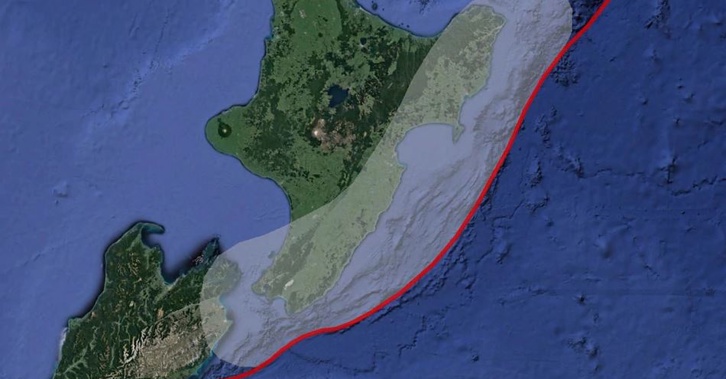
Scientists have warned a "megathrust" earthquake could release 2000 times more energy than the 2011 Christchurch earthquake that killed 185 people.
The risk comes from the Hikurangi subduction zone, a fault that runs along East Coast where the Pacific and Australian tectonic plates collide.
Scientists are discussing the risks it poses at a summit in Napier this week.
They say it could trigger a massive 8.4 magnitude quake, that would cripple the lower North Island.
GNS Scientist Dr Laura Wallace told TVNZ the area had "the potential to produce the world's largest earthquake and tsunamis".
Marcus Hayes-Jones, of the Napier Civil Defence, said he "can't emphasise how serious" NZ must take this "genuine risk".
In 2015 scientists uncovered evidence that two major "megathrust" earthquakes that triggered both the 2011 Japanese and 2004 Boxing Day tsunamis hit central New Zealand in the past 1000 years.
The breakthrough discovery had confirmed the risk this type of earthquake, more powerful and potentially destructive than normal quakes, poses to New Zealand.
GNS Science earthquake risk analyst Nick Horspool said if a Japanese-style quake of the same magnitude were to hit central New Zealand, thousands of people could be killed and tens of billions of dollars lost.
Horspool estimated the potential impact using a computer model.
"If it was a magnitude 9, we'd have really strong shaking the whole way up the East Coast of the North Island and even the top of the South Island - intensities near [to] what was experienced in Christchurch.
"There would be widespread damage, damage to buildings and infrastructure, and following that you would then have a tsunami."
He said the tsunami would devastate the coastal areas and cause further destruction to buildings and infrastructure.
The exact number of casualties would depend on how many people were able to self-evacuate.
"Because it's going to be a large, strong shaking... then 10 minutes later there will be the tsunami coming."
Horspool said in the event of a tsunami, wooden buildings were probably more vulnerable than concrete ones.
"We don't have direct evidence from New Zealand events... but what was seen in Japan was that the wood buildings were a lot more vulnerable than the multi-storey concrete buildings."
A combination of elevation above sea level and distance from shore defined the extent of tsunami-prone areas.
Subduction quakes are different from normal earthquakes in that they occur on the under the surface of the upper plate - where two tectonic plates meet - instead of on faults within the upper plate.
They have the potential to be bigger in magnitude than fault ruptures closer to the surface, tend to affect larger areas, and are more likely to trigger a tsunami.
The study's lead author, Kate Clark from GNS Science, said the findings were significant as they helped to further understand earthquake and tsunami hazards in the lower North Island and upper South Island.
"Subduction earthquakes are not a 'new' risk for New Zealand, as we have always assumed they can occur, and they are accounted for in our seismic hazard models," she said.
"This study is significant in that it confirms that risk."
Although the evidence from just two earthquakes was still not enough to calculate when the next subduction earthquake would occur, or its exact magnitude, she said: "It [was] most likely to be greater than magnitude 7."
Scientists have previously found evidence of subduction earthquakes occurring under Hawkes Bay, but this was the first time they had found direct geological evidence that the southern part of the Hikurangi Margin could rupture in an earthquake.
They identified the quakes from sediment cores extracted from Big Lagoon, a large coastal lake east of Blenheim.
The older of the two earthquakes identified at Big Lagoon also triggered a three-metre-high tsunami that travelled inland about 360m.
The research was outlined in the Bulletin of the Seismological Society of America, published in 2015.
Victoria University Associate Professor John Townend, EQC Fellow in Seismic Studies, said the study provided the first substantiated evidence for large subduction zone earthquakes in the area, and would enable New Zealand's seismic hazard model to be "refined".
"In order to understand the hazard posed to New Zealand by future large earthquakes, we need to know when such earthquakes have occurred in the past - and how big they were.
The challenge with this is that the earthquakes of most interest happen very infrequently."
Wellington region Civil Defence controller Bruce Pepperell said the research provided "a little more clarity" on earthquake occurrence but would not change safety messages and evacuation plans.
Mr Pepperell said if people felt quakes for a minute or more or were knocked off their feet, that may be the "best and only warnings" of an imminent tsunami.
He said "drop, cover and hold" remained the basic safety message for people caught in quakes.
Take your Radio, Podcasts and Music with you









